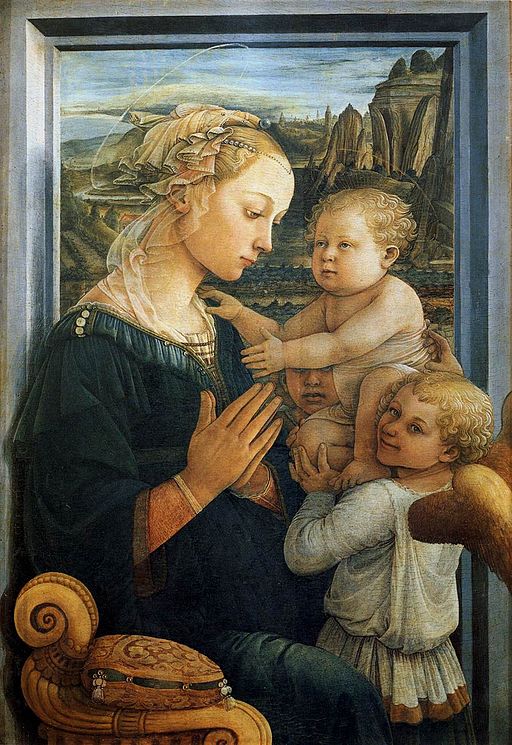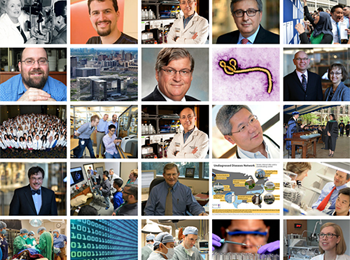What academic medical centers can learn from Lippi

What does this 15th century Renaissance painting have to do with a 21st century academic medical center?
Painted by Fra’ Filippo Lippi (a monk of some questionable repute) in about 1465, I selected this image as an analogy for our two broad challenges in building a successful academic medical enterprise in the rapidly changing healthcare environment.
The first challenge is the need to innovate.
At first blush, Lippi’s Madonna With Child and Two Angels may not scream innovation. However, in its time it included a number of groundbreaking techniques.
For a moment, focus on the landscape in the background of the painting. The use of realistic perspective was an innovation of the period, and separated it from flat two-dimensionality of medieval art.
Note also the painted frame surrounding the scene; the placement of the characters in front of the frame brings them into the world of the viewer. Coupled with the cherub in the lower right – who makes direct eye contact with the viewer, and looks like he knows a secret he wishes to share – the effect is to draw you into the painting.
This is a degree of interactivity that would have been startling at the time; something akin to watching a 3D movie when all you have known is black-and-white television.
The need for innovation in today’s academic medical center is driven by the pace of economic, demographic and scientific change. This topic could consume (and probably deserves) many pages of discussion.
However, at least some of the challenge is represented in the Institute of Medicine’s call to create the learning health system (LHS) of the future from the academic medical center (AMC) of the past.
A learning health system uses data to drive continual improvement in the care of patients. All three words – learning health system – have meaning.
Academic could be interpreted by some as detached and separate from the care delivery system. Note, that one secondary definition of the word “academic” is “theoretical, speculative; having no practical or useful significance.”
Learning implies a continuous and ongoing feedback loop. The process of discovery and acquisition of new knowledge, while still invaluable in their own right, must be actively applied to improve care. Care that is suboptimal or inconsistent across populations must be a major catalyst for the process of discovery.
Medical strongly suggests we are focused on the diagnosis and treatment of disease –still a priority in the new world order.
However, the concept of health broadens the mission. Not only will our emerging LHS develop startling new treatments, we will also take responsibility for maximizing the health of populations.
Prevention of disease and improvement of environmental and behavioral determinants of health will become much more critical components of an institution’s academic portfolio.
Center strongly invokes a specific place (perhaps an ivory tower). The concept of system conveys a heightened priority on connectivity.
In the traditional model, the care delivery system is where learners go to practice when they finish training. In the emerging model, learners and the educational process will be integrated into the delivery system.
In the academic medical center, research produces knowledge that is pushed out to providers of care. Frequently, it takes many years for this knowledge to be integrated into practice for the benefit of patients.
In the learning health system, the acquisition of new knowledge remains critical. However, in addition, the science of care delivery – the implementation of new knowledge – takes on added importance. The care delivery system becomes an important laboratory.
The second challenge represented by Lippi’s painting is the changing nature of the “halo effect” in academics. The Madonna’s halo is faint and ethereal. It does not jump off the canvas at the viewer, and could even be missed by the casual observer.
This reflects the diminishing value the patina of academia has for health care systems.
Over the past half a century, in a system relatively flush with revenue, a hospital could reasonably be expected to contribute resources to education and research almost purely for the associated reputational benefit.
In the emerging health care economy, hospital margins are small against historical standards, and economic success is driven by managing cost and improving outcomes. The economic value of reputation is waning.
The challenge for the LHS of the future will be to repaint Lippi’s halo with heavy, bold, thick brushstrokes.
Successful learning health systems must foster partnerships with successful care delivery systems (like Catholic Health Initiatives). Ideal partnerships will be mutually symbiotic: the care delivery system will provide new academic opportunities for educators and researchers.
In return, the engine of academia must drive concrete strategic advantage back to the health system partner. I will develop this concept more fully in a future posting.
Lippi’s Madonna and Child frames the questions we all need to be asking of ourselves. How does my work help the Baylor College of Medicine drive the culture of innovation necessary to be the national model of a learning health system?
How do our great strengths in education and research drive measurable strategic benefit to our health system affiliates and partners? Finding the right answers to these questions will drive our success for decades to come.
–By James T. McDeavitt, M.D., Dean of Clinical Affairs, Senior Vice President, Strategy & Growth, and Professor and Chair for the Department of Physical Medicine & Rehabilitation at Baylor College of Medicine




Pingback: What Academic Medical Centers Can Learn from Lippi | Wing of Zock